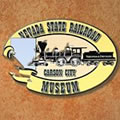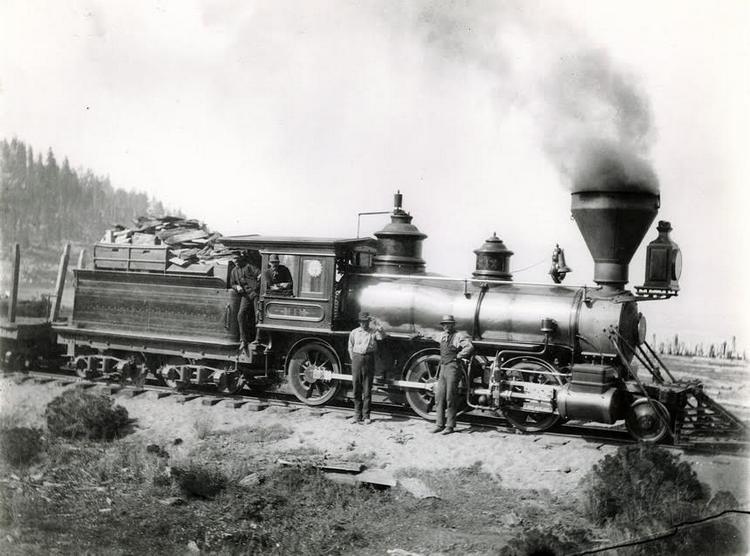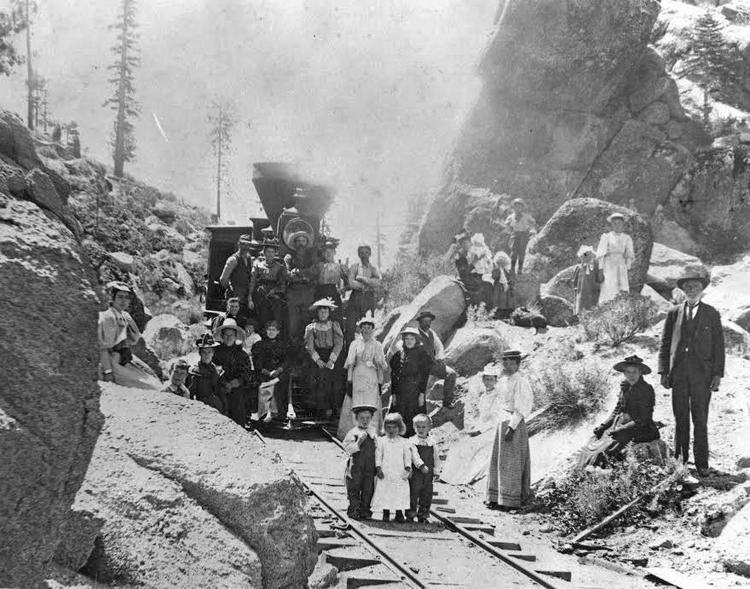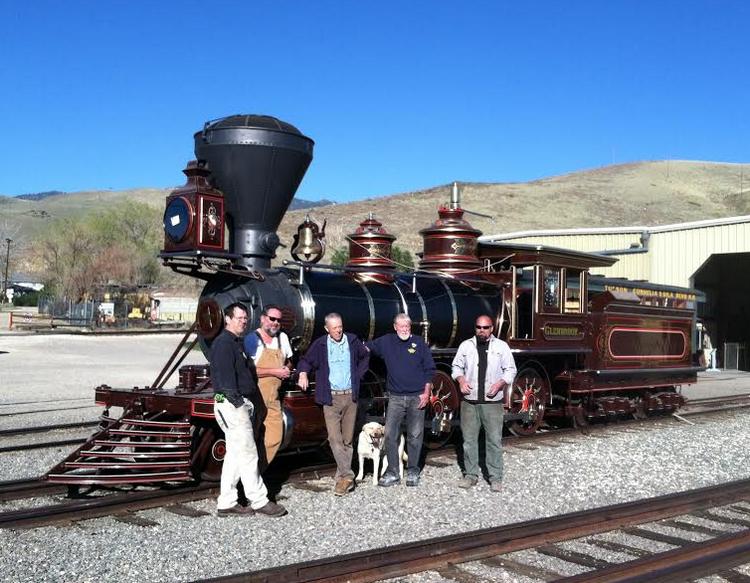by Wendell Huffman
After slumbering for 90 years, the locomotive Glenbrook is once again under  steam, blasting its whistle just a few miles from where it ran in 1875.
steam, blasting its whistle just a few miles from where it ran in 1875.
The Glenbrook is a narrow gauge 2-6-0 locomotive which first operated on the railroad of the Carson & Tahoe Lumber & Fluming Company, a company which supplied mine timbers, lumber and cordwood to the Comstock. Logs were cut at various places around Lake Tahoe and towed by steamboats to the company’s sawmills at Glenbrook, on the Nevada side of the lake. Initially, the mills’ output was hauled by teams and wagons to Spooner Summit, from which point it was floated down the eastern side of the Carson Range in a 12-mile flume. This flume terminated just south of Carson City, where Fairview intersects with Carson Street. From that point, the timbers and cordwood were carried on to Virginia City on the cars of the Virginia & Truckee Railroad. An eight-mile three-foot gauge railroad between Glenbrook and Spooner eliminated the wagon haul in 1875. The steamship Glenbrook and its twin the Tahoe pulled trainloads of timber products up this railroad for 24 years, until demand from the Comstock faded.
 With the decline of the Comstock and the associated lumbering industry, Duane L. Bliss, principal of the Carson & Tahoe Lumbering & Fluming Co. refocused his attention on making Lake Tahoe accessible to tourists. Toward this end he organized the Lake Tahoe Transportation Company in 1895 to operate steamboats on the lake, and in 1898 organized the Lake Tahoe Railway & Transportation Company to construct a 15-mile railroad along the Truckee River between Tahoe City and Truckee, where it connected with the trains of the Southern Pacific Railroad. In 1899 the rails and most of the equipment from the old C&TL&F Co. lumber railroad was moved from Glenbrook to the new operation at Tahoe City, and the new railroad formally commenced operation in May 1900. The old locomotive Glenbrook became No. 1 on the LTR&TCo.
With the decline of the Comstock and the associated lumbering industry, Duane L. Bliss, principal of the Carson & Tahoe Lumbering & Fluming Co. refocused his attention on making Lake Tahoe accessible to tourists. Toward this end he organized the Lake Tahoe Transportation Company in 1895 to operate steamboats on the lake, and in 1898 organized the Lake Tahoe Railway & Transportation Company to construct a 15-mile railroad along the Truckee River between Tahoe City and Truckee, where it connected with the trains of the Southern Pacific Railroad. In 1899 the rails and most of the equipment from the old C&TL&F Co. lumber railroad was moved from Glenbrook to the new operation at Tahoe City, and the new railroad formally commenced operation in May 1900. The old locomotive Glenbrook became No. 1 on the LTR&TCo.
The narrow gauge LTR&TCo. railroad operated for a quarter-century, carrying passengers and freight between Lake Tahoe and Truckee. In an effort to improve the connection between the lake and the outside world, the LTR&TCo. leased its railroad to the Southern Pacific in 1925 with the proviso that the railroad be converted to standard gauge. This was accomplished to the company’s satisfaction in 1926 and title to the railroad was transferred to the SP the following year. Recognizing the tourist value of their new branch to the lake, the SP promoted their cross-Sierra mainline as the “Lake Tahoe Route”.
 Most of the equipment of the old narrow gauge railroad, including three of the line’s four locomotives, was scrapped. However, the Bliss family retained the Glenbrook with the intention of preserving and displaying it at Tahoe City. For over a decade the old engine was stored at Tahoe City, but satisfactory arrangements for its display were never realized. Finally, in 1937, it was sold to the Nevada County Narrow Gauge to provide needed parts for its old mate, the Tahoe, which had been running there since 1898.
Most of the equipment of the old narrow gauge railroad, including three of the line’s four locomotives, was scrapped. However, the Bliss family retained the Glenbrook with the intention of preserving and displaying it at Tahoe City. For over a decade the old engine was stored at Tahoe City, but satisfactory arrangements for its display were never realized. Finally, in 1937, it was sold to the Nevada County Narrow Gauge to provide needed parts for its old mate, the Tahoe, which had been running there since 1898.
With the abandonment of the NCNG in 1942, Hope Bliss, daughter of Duane L. Bliss, purchased the Glenbrook from the scrapper with the specific intention of donating it to the Nevada State Museum, which had been created in 1941. The Bliss family recognized that this institution could preserve the Glenbrook. It was shipped by rail from Colfax to Carson City in June 1943 and was immediately set up on the museum grounds.
Eventual restoration of the locomotive was a goal when it was acquired in 1943, and a concerted effort was made to collect all of the parts which had been removed subsequent to its sale in 1937. However, while the Glenbrook was displayed outside the Nevada State Museum for nearly four decades, restoration was a long unfulfilled dream. Eventually, in July 1981, it was relocated to the Virginia & Truckee Railroad Museum (subsequently Nevada State Railroad Museum), which was then restoring several old pieces of Virginia & Truckee rolling stock. While significant work on the Glenbrook was accomplished between 1981 and 1986, little was done in the subsequent twenty-three years, as other projects competed for priority. Finally, restoration began in earnest in 2010 when funds from the E.L. Wiegand Foundation were awarded to support the project, and the beautifully restored locomotive was operated for the first time in 89 years in May 2015.
 Carson & Tahoe Flume & Lumber Company No. 1, Glenbrook, is a genuine memento of the Comstock, having worked to haul trains of lumber destined to shore up the Comstock mines and build Nevada’s first cities and cordwood to feed its furnaces. It subsequently participated in Nevada’s fledgling tourist industry, pulling trainloads of visitors to Lake Tahoe. Moreover, the Glenbrook was the first railroad artifact presently owned by the State of Nevada to have been set aside for preservation. While that initial attempt by the Bliss family to preserve the locomotive was not immediately fulfilled, they nevertheless spared the locomotive from destruction and reacquired the locomotive for donation to the state in 1943. With that donation, the Glenbrook became the first railroad artifact to be owned and preserved by the Nevada State Museum.
Carson & Tahoe Flume & Lumber Company No. 1, Glenbrook, is a genuine memento of the Comstock, having worked to haul trains of lumber destined to shore up the Comstock mines and build Nevada’s first cities and cordwood to feed its furnaces. It subsequently participated in Nevada’s fledgling tourist industry, pulling trainloads of visitors to Lake Tahoe. Moreover, the Glenbrook was the first railroad artifact presently owned by the State of Nevada to have been set aside for preservation. While that initial attempt by the Bliss family to preserve the locomotive was not immediately fulfilled, they nevertheless spared the locomotive from destruction and reacquired the locomotive for donation to the state in 1943. With that donation, the Glenbrook became the first railroad artifact to be owned and preserved by the Nevada State Museum.
The locomotive is proudly exhibited in the Jacobson Interpretative Center of the Nevada State Railroad Museum. It is operated by volunteers on special occasions.










